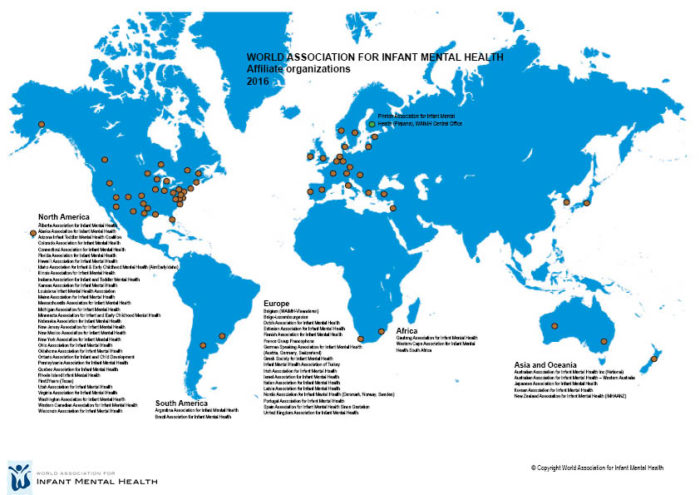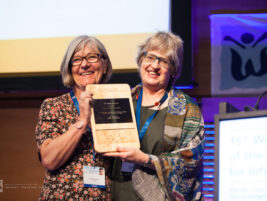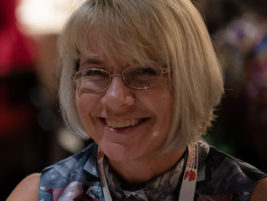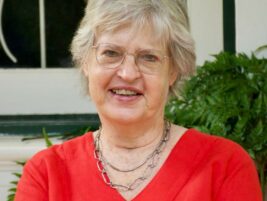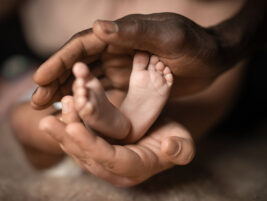


May 3, 2012.
After a 12-hour flight on a fully booked plane-but nowadays planes are always full- Nicole and I land in Montevideo. We are greeted by Nahir Bonifacino, psychologist and psychoanalyst, from the infant team at the Children’s hospital Peirerra Rossel. This is my third time in Uruguay. It’s Nicole’s first visit to Uruguay and her first time in South America.
We are here because we’ve been invited to provide a three day course in the child psychiatric department of Pr Viola in the main public paediatric hospital Peirrera Rossel in Montevideo. This event has been organized by Dora Musetti, a child psychiatrist and psychoanalyst. The course is held under the auspices of APPIA, the Uruguayan branch of WAIMH, headed by Julia Ojeda de Prego.
Like the plane, the program is full. It includes: Four interventions each day at the hospital; interventions at the university and at the City Hall; and finally at the Uruguayan Psychoanalytic Association. The social program is also quite busy.
Nicole talks about adoption and attachment. She talks about the development of attachment, about the importance of developing a working relationship with families, and about the importance of the first session with a toddler and his or her family. I talk about: the familial and social influences on early development, on the paediatric consultation as an opportunity for screening both infants and parents’ mental health, on ADBB and on early prevention.
While we talk, we listen and reflect; past and present dance. ‘Twenty years after’ as in the famous French novel by Alexandre Dumas, here I am, back in the great city of Montevideo. However, I am re-minded of my first visit. The ambiance in the eighties was much gloomier. The country was in economic marasmus and still in the aftermath of the dictatorship. Many people were still away, expelled by the dictators. The memory of the missing, people who died in prison or babies having been separated from their parents and sent into foster families was still very present. The city was quiet. It was sad, it was gray. My talk at the UPA was received coldly as it did not abide with the rules of psychoanalytic thinking.
Amidst this rather gloomy ambience, there was light. I had had the honour to be received by the founding member of the Uruguayan child psychiatry, the famous Professor Prego. It was a brief visit, at his home, as Prego was already retired and quite aged. He was an impressive man, quite warm in fact and we had an interesting exchange. He looked a bit like Gabriel Marquez, the author of “A Hundred Years of Solitude”, a major book in South American literature. I had met with his Prego’s son, also a child psychiatrist and with several psychoanalysts and researchers such as Ricardo Bernardi and Marina Altman de Litvan, a WAIMH member. They were a very active group, working on lullabies and on early mother infant relationships.
People were working incredibly hard, from 8 am to 10 pm. They worked between hospital practice where they received almost no salary; and they worked in private psychoanalytical practice. But students were numerous at the courses and several came to France to follow courses at the Institut de Psychosomatique, where I was working at the time. Child psychiatry was organized around and by Miguel Cherro, who teamed closely with Salvador Celia from Brazil and with Miguel Hoffmann from Argentina.
I am now brought back to the present; back to Uruguay nowadays. My impression of the ambiance is quite different now. The city is awake and lively, with 1.5 million people in the Montevideo area. It is considered one of the safest cities in South America and one with the highest quality of life, which may not be true for all, as the average income is 8400 UDS. Uruguay is also the only country in South America to have a temperate climate. Business seems to be active, with a growing alimentation industry. Uruguay is a little country with 3.5 million inhabitants. It sits between the two giants: Brazil on the north and Argentina on the south. There are still descendants from the Indians Guaranis and Charuas; and also a black minority mostly from Brazil, but most of the people are from European descent. The level of education is the highest in South America, and it also has the highest level of literacy.
Uruguay had a golden age around 1900 till 1920, and was called the Swiss of South America before being hit by the 1929 crisis. However, poverty is still high, around 40 % but this has decreased by 50% within the last 5 years. Growth rate is 6% and unemployment is 10%, but the birth rate is low, except with the poorest. Uruguay came out of a financial crisis in 2005. After a long period of military dictatorship and death squadrons, from 1971 to 1980, Uruguay came back to democracy. It recently elected a large left front, in 2009 with a president, José Mujica. This new government are former urban guerilla, the TUPAMAROS. They do not come from the traditional Colorado or Blanco party. The president is a medical doctor, who spent 13 years in jail and most of it in isolation. The ministry of culture is a high level neuroscientist, who was tortured then exiled in France. Their discourse is rather unusual for politicians in that they speak openly and freely.
Amidst this new ambiance, Nicole and I had a day teaching at the city hall. This was a rather impressive building, with a rather Stalinian-like architecture. We were in the main auditorium. It was very beautiful. Attendance was large and the conferences were open to the public. I gave a talk on early development. Nicole talked about the role of front-line workers in infant mental health and about the need for them to be trained in attachment issues and in making working alliance.
A professor of paediatrics; a colleague and a politician who is responsible for the nation early prevention politics gave the first opening talk. The inter-play between what he talked about with what I and Nicole talk about takes me by surprise. The talk he made was very close to mine and Nicole’s.
I have never listened to such a talk from a high ranking health manager and politician. He spoke with such knowledge of the importance of early development. He highlighted the importance of cognitive and emotional development in infants with the centrality of parent infant interaction, as the foundation for a solid and good enough mental development. The idea was clear: Infants are our future. Our investment in their development is an investment in the development of the country, particularly since the birth rate is so low in middle class people, and high in very poor people. Prevention and early intervention is taken very seriously. The goal of reduction of poverty and of bringing early attention to physical and emotional development has been labelled as a priority by the president.
Of course things are never too simple. This talk referred to psychoanalysis, which is the main culture in mental health in Uruguay. There is still a journey to make to bridge the use of psychoanalysis with the goal to invest now, in infants and their relationships. What Nicole and I brought to this conversation, through our parent-infant focused intervention with an emphasis on attachment issues, supported the move to bring psychoanalysis into the here and now: of real life relationships (Amidst history and politics) and of taking care of the parents with infants as way to build a safe present with good enough mental health.
To further illustrate the dance between bringing infants and their families into view with the day-to-day context of people’s lives, in the afternoon, Nicole got herself stuck into a Uruguayan-Uruguayan debate, in which harsh critics were launched towards ‘people in Montevideo getting all the money and nothing be spared for people working in the country’.
Further showing the exciting growth in the field of infant and family mental health, in Uruguay, and South America more generally, we also had a day of presentations by Uruguayan clinicians and researchers. The Infant team presented their experience with training the paediatricians with the ADBB and assessing changes in their clinical practice after training. The team, Nahir Bonifacino, Dora and Andrea Plevak, paediatrician had received a grant from IPA, and they had received financial help from my research association APRA. The Uruguayan team had trained with Dr Monica Oliver’s Argentinian team at the Alleman Hospital in Buenos Aires in 2008. Andrea Plevak and Nahir Bonifacino have developed an expertise in scoring with the ADBB and in training, and this is to be used by the Spanish Valencia faculty to train some PhD students.
Moreover, the results of a recent study were presented, with ADBB assessments made in well baby clinics (beautifully and adequately named Centro de Attencion Infantil). The study showed a high rate of withdrawal behaviour and showed the rate was double in very poor districts of town. The next study will make use of the astute system of prevention in the Centros de Attention Infantil: in these public centers, families and infants are seen freely each month for the first year of life, with attention to the physical and emotional development of the child. But if the family fails to show up for two meetings, then the team schedule a home visit. A trial of effectiveness of using video for the examination of the child’s development will be done shortly.
In addition, a presentation by the head of the Institute Pasteur in Montevideo gave a very nicely illustrated and very up to date account of the risk and resiliency factors in early development. An ambitious study on oxitocin in the post partum was also presented, so research in the perinatal field is quite active.
Salvador ‘s Celia brilliant idea of la ‘Semana do bebe’ in Porto Allegre (the week of the infant) has finally taken, up here, with a Day of the Infant beginning this year. Let us be reminded that there was a very successful regional WAIMH/ IACAPAP /ISAP joint meeting in Punta del Este, in 1980. Also Miri Keren and I were invited two years ago by ASMI Argentina in Buenos Aires, to talk about organizing a South American WAIMH affiliate group, to include among others: Brazil, Argentina, Uruguay and Chile, and possibly Mexico, since most of these countries have a fairly active WAIMH affiliate society. Miri was here in Montevideo last year, after the WAIMH Capetown congress. She was sponsored by the Israeli embassy; and my trip was sponsored by the French embassy.
There is momentum here, and in the South America. The time may have come for a new surge of collaboration between these countries, on a sort of MERCOSUR for the baby, as these countries are sharing a lot of common experiences.
After a 12 hour flight, on another fully booked plane, Nicole and I land in Paris. The connections are strong. We remain mind-full of Uruguay and the tremendous efforts and work of our colleagues across South America.
Authors
Guedeney, Antoine,
Paris, France


